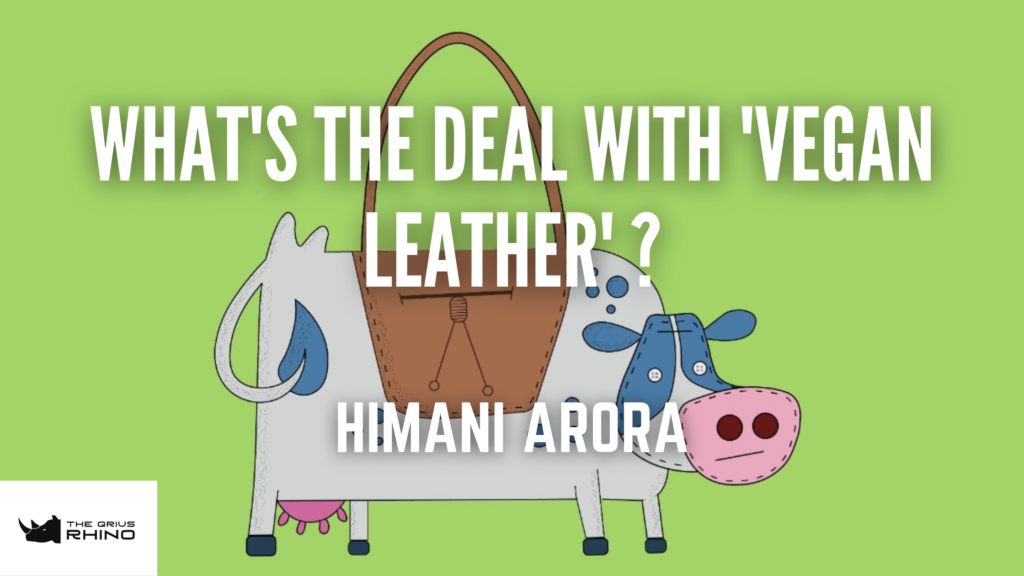
Have you been wanting to buy that stunning leather jacket that has been sitting in your shopping cart for too long now but can’t, without contributing to the dreadful activities of leather making, you guessed it – sacrificing animals for their skin.
Several people turn to ‘vegan leather’. On its face, it might seem a better alternative, but they are falling victim to ‘green washing’ – claiming to deceive consumers into believing a product is more environmentally friendly than it actually is.
So, what is ‘Vegan Leather’?
Vegan leather is a material that mimics leather, but is created from artificial or plant products instead of animal skins. The question still stands. Is it a more sustainable option than real leather? Well, not exactly.
Very few vegan leathers are actually made from natural materials. The most commonly used materials for synthetic leathers are PolyVinyl Chloride (PVC) and PolyUrethane (PU). Both these products consist of plastic chemicals and petroleum compounds (which is far from ideal).
Clothing made from these can pose a threat during and after its lifespan. It could end up in a water body or a landfill which releases toxic chemicals into the environment and takes years to degrade. It is estimated that 13 million tonnes of synthetic fibres enter our oceans each year.
However, vegan leather options with natural products as their raw material do exist!
Piñatex is a leather product made from the waste parts of a pineapple plant, (mainly pineapple leaves). Although pineapple fibres are 100% biodegradable, the resins used in the coating are not. So it’s close, but not quite there yet.
Cork leather, made from the bark of Cork Oak Trees that grow in the Mediterranean regions, is incredibly durable, elastic and lightweight. It is also hypoallergenic, anti-fungal and waterproof.The oak tree can survive even after the bark is harvested, that aimed to protect the tree against dehydration, fungus and insects.
Mushroom leather, or ‘MuSkin’, is made from the roots of the mushroom plant. It is the most durable vegan leather on the market.
There are endless examples of innovative ways to replicate animal-leather in a cruelty-free and sustainable way.
But what makes real leather unsustainable, apart from sacrificing animals for their skin (duh!)?
Its manufacturing process – tanning, uses strong chemicals to break down proteins in the skin. If the chemicals find their way into the water, it causes an excessive richness of nutrients that sparks the growth of algae and animal death due to the lack of oxygen in the waters. In extreme cases, workers in the tanneries are exposed to serious health risks such as lung cancer and leukaemia.
While these are some devastating facts, leather also helps make the slaughter of animals more economically viable. Utilizing animal hides (which represents about 10% of its value) which were killed for meat, makes it more practicable. However, many of the more luxurious and exotic leathers come from animals that have been specifically slaughtered for their skin. This includes snakes and crocodiles, and even calf foetuses. So not all leather is equal in this regard.
Genuine leather can also be a safer option, considered they are ‘vegetable-tanned‘ instead of the traditional way. Natural tannins (like tree bark) are used in this process. The products made have no negative environmental impact. It develops a rich and beautiful patina, and actually gets better with time and use. It doesn’t crack or dry out and thus has a very long lifespan.
The argument on sustainable leather can’t be all black and white but it pays to do your research before you guilt or pride yourself in buying a leather product.
This is the third blog of the series “The Science Behind” by Himani Arora.
About the author:

Himani is a final year Master’s student at Banaras Hindu University at the Department of Zoology, India. She aspires to be a Science Communicator. She has gained good experience in this domain. Himani writes science articles, creates visuals (infographics, posters), and also draws science comics.
You can follow her work on S’more Science.
You can also follow her on Linkedin.